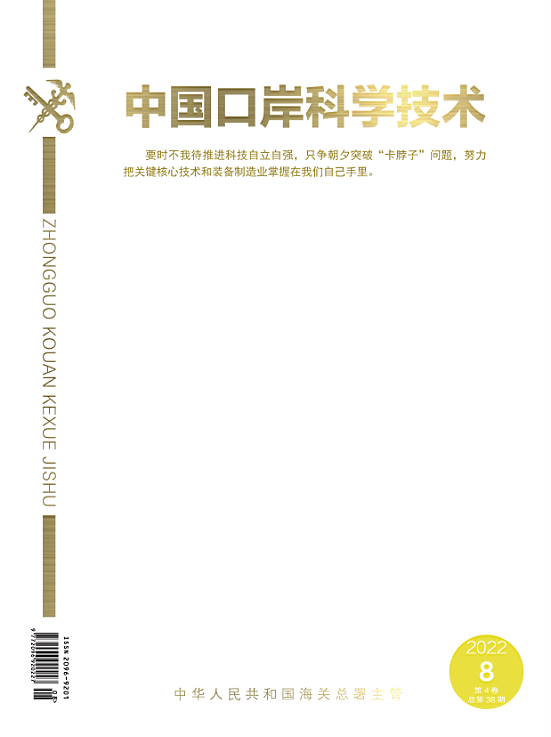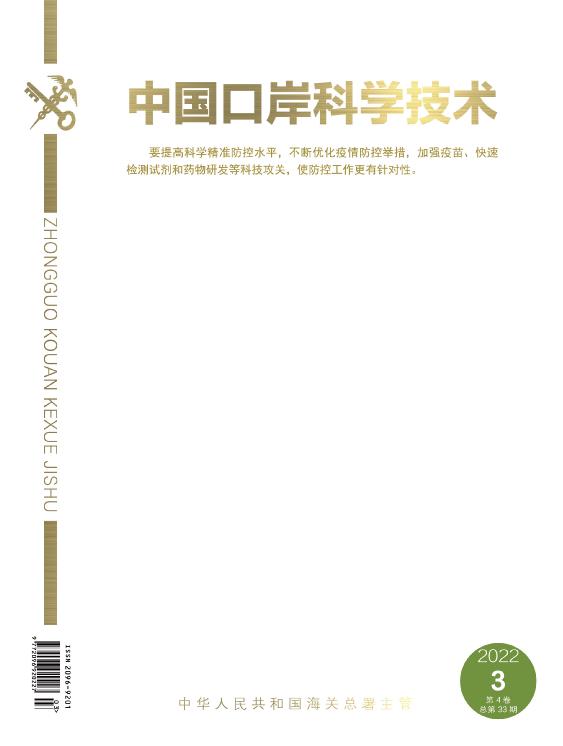CopyRight 2009-2020 © All Rights Reserved.版权所有: 中国海关未经授权禁止复制或建立镜像
进口宠物饲料中动植物成分符合性检测与结果分析
作者:虞惠贞 张明哲 尹文秀 张晓峰 裘慧 张荃 江惠君 吴姗
虞惠贞 张明哲 尹文秀 张晓峰 裘慧 张荃 江惠君 吴姗
Abstract In order to understand the quality and security risks of imported pet feeds, and verify whether the animal and plant ingredients of pet feeds are consistent with the labeling, real-time fluorescent PCR detection of animal-derived ingredients, plant ingredients and genetically modified ingredients was carried out on pet feeds which were purchased from online platforms and physical stores, and the results of PCR were analyzed. The results of animal-derived ingredients showed that 56 out of 136 pet feeds were inconsistent with the ingredients in the labeling and the non-conformity rate was 41.18%. The non-conformity rate of pet feeds from online was 50.60%, and that of the pet feeds purchased from the store was 26.42%. The detection of plant ingredients was conducted in 27 pet feeds indicated grain-free, among which 23 were detected to contain grain ingredients. The detection rate was as high as 85.19%. Genetically modified (GM) plant components were detected in 21 of the 56 pet feeds containing plant components, with a detection rate of 37.50%. The compliance test of the above-mentioned imported pet feeds with animal and plant ingredients revealed that the non-conformity with the product identification is a widespread phenomenon, and the so-called "grain-free" feed often contains grain, and the use of genetically modified raw materials in the feed is more common. The imported pet feed in the physical store is superior to the online platform in terms of composition compliance.
Keywords pet feed; compliance test; GM detection
随着生活水平的提高,饲养宠物逐渐成为人们生活的一部分,宠物饲料行业也迎来快速发展,产量呈现每年约30%的增量[1]。第三方交易平台迅速发展和销售便捷性,使得网络宠物饲料的销售呈现快速发展趋势。其中,进口宠物饲料以营养全面和品种齐全的特点获得国内消费者的青睐,但进口宠物饲料大量进入国内市场的同时,品牌、质量良莠不齐,尤其是缺乏监管的电商平台上存在大量的低质量、不知名的宠物饲料产品。宠物饲料成分复杂,很容易掺杂使假,部分不良生产商为追求经济利益,在宠物饲料生产过程中加入成本较低的肉制品以及在无谷饲料中掺入谷物成分,或无意识在饲料中混入标签中未注明的其他蛋白成分,造成交叉污染,这些很可能引起宠物过敏,甚至死亡[2-5]。此外,为了降低生产成本,一些宠物饲料采用转基因植物为原料,却不在包装中注明[6]。
国外针对宠物饲料成分符合性研究较多。在英国的一项研究中,Maine等[7]测试从超市采购的17种宠物饲料中的牛、鸡、猪和马成分,发现有15种饲料检测结果与标签不符。在美国,Willis等[8]用ELISA方法在声称不含大豆成分的宠物食品中检出了高浓度大豆蛋白。在奥地利,Horvath等[9]通过PCR技术在10种宠物食品中检测出9种标签上未标明一种或多种动物的DNA。而国内关于宠物饲料中成分检测研究所涉及物种相对单一,且缺乏针对进口宠物饲料的市场调查[10]。为了加强进口宠物饲料标签管理,预防饲料掺假或污染,保护消费者利益和宠物健康,保障宠物饲料安全和质量,本研究参照行业标准,对采购的进口宠物饲料进行动物源性成分(牛、羊、猪、鸡和鸭)、谷物成分(玉米、大豆、大米和小麦)和植物转基因实时荧光PCR方法检测,并与标签进行比对,了解进口宠物饲料的质量安全风险。
1 材料和方法
1.1 样品
进口宠物饲料样品的原产地及购买途径和样品数量等信息见表1。
表1 进口宠物饲料原产地、购买途径及数量
Table 1 Country of origin, means of purchase and quantity of imported pet feeds
原产地 | (个) | (个) | (个) |
澳大利亚 | 4 | 8 | 12 |
比利时 | 7 | 0 | 7 |
德国 | 5 | 0 | 5 |
加拿大 | 25 | 28 | 53 |
美国 | 14 | 13 | 27 |
日本 | 8 | 0 | 8 |
泰国 | 7 | 0 | 7 |
新西兰 | 7 | 4 | 11 |
意大利 | 3 | 0 | 3 |
法国 | 3 | 0 | 3 |
总计 (个) | 83 | 53 | 136 |
1.2 DNA抽提
取样品2 g,碾磨至粉状,用核酸提取试剂盒DNeasy mericon Food Kit (50)(QIAGEN 69514,德国)进行DNA抽提,提取过程参照试剂盒说明书,抽提得到DNA溶解在100 μL去离子水中。
1.3 动物源性成分检测与结果判定
检测了牛、羊、猪、鸡和鸭等动物成分,其中牛、羊和猪的检测方法参照SN/T 2051-2008《食品、化妆品和饲料中牛羊猪源性成分检测方法 实时PCR法》[11],鸡和鸭的检测方法参照SN/T 2727-2010《饲料中禽源性成分检测方法 实时荧光PCR方法》[12]。
每个检测重复3次,2次或2次以上检测结果为阳性,则判定为检出此动物成分。不论检出或者未检出,只要和产品标签中标注的不同,即视为不符合。
1.4 谷物成分检测与结果判定
检测了大豆、玉米、大米和小麦成分,检测方法参照SN/T 1201-2014《饲料中转基因植物成分PCR检测方法》[13]。
每个检测重复3次,2次或2次以上检测结果为阳性,则判定为检出此谷物成分。因为标注为无谷粮,即检出上述任何一项视为不符合。
1.5 植物转基因检测与结果判定
检测了转基因外源启动子(CaMV35S)和终止子(NOS),检测方法参照SN/T 1201-2014。
每个检测重复3次,2次或2次以上同时检出CaMV35S和NOS,即视为检出植物转基因成分。
2 结果和分析
2.1 动物源性成分检测
动物源性成分检测中,共检测到56个不符合产品,其中42个购自网络平台,原产地分别为澳大利亚、比利时、德国、加拿大、美国等国家;14个购自实体店,来自加拿大和新西兰,见表2。56个不符合产品中,只有1种成分不符合的占55.36%,2种成分不符合的有31种,占35.71%,3种成分不符合的有5种,占8.93%,没有发现同时有4种或4种以上成分不符合的样品,见表3。检测的5种成分,牛成分的结果相对较好,只有8个样品有问题,其中6个标识为无的产品中检测到了牛成分,2个标识含牛的样品检测结果为阴性;羊成分有16个样品检出有问题,其中12个标识为无的产品中检出了羊成分,另外4个标识含羊的样品检测结果为阴性;猪成分有20个样品检出有问题,其中19个标识为无的产品中检出了猪成分,另外1个标识含猪的样品检测结果为阴性;鸡成分有15个样品检出有问题,其中15个标识为无的产品中检出了鸡成分,另外3个标识含鸡的样品检测结果为阴性;鸭成分有24个样品检出有问题,同样集中在标识为不含鸭的产品中检出了鸭成分,如图1所示。
表2 不同原产地的宠物饲料中动物源性成分不符合情况分布
Table 2 Non-compliance distribution of animal-derived ingredients of different origins in pet feeds
原产地 | (个) | 不符合数量(个) | (%) | ||
网络平台 | 实体店 | 合计 | |||
澳大利亚 | 12 | 1 | 0 | 1 | 8.33 |
比利时 | 7 | 5 | 0 | 5 | 71.43 |
德国 | 5 | 2 | 0 | 2 | 40.00 |
加拿大 | 53 | 17 | 13 | 30 | 56.60 |
美国 | 27 | 10 | 0 | 10 | 37.04 |
日本 | 8 | 3 | 0 | 3 | 37.50 |
泰国 | 7 | 0 | 0 | 0 | 0.00 |
新西兰 | 11 | 1 | 1 | 2 | 18.18 |
意大利 | 3 | 1 | 0 | 1 | 33.33 |
法国 | 3 | 2 | 0 | 2 | 66.67 |
总计 | 136 | 42 | 14 | 56 | 41.18 |
网络平台采购的宠物饲料不符合率为50.60%,实体店采购的宠物饲料不符合率为26.42%,网络平台购得的宠物饲料不符合率高于实体店购得,见表3。
表3 宠物饲料的动物源性成分不符合情况分布
Table 3 Non-compliance distribution of animal-derived ingredients in pet feeds
采购方式 | (个) | 不符合数量 (个) | (%) | |||
1种 | 2种 | 3种或3种以上 | 合计(个) | |||
网络平台 | 83 | 22 | 16 | 4 | 42 | 50.60 |
实体店 | 53 | 9 | 4 | 1 | 14 | 26.42 |
总计 | 136 | 31 | 20 | 5 | 56 | 41.18 |
图1 宠物饲料动物源性成分不符合分布图
Fig.1 Distribution of non-compliance of animal-derived ingredients in pet feeds
2.2 植物源性成分检测
宠物饲料检测中,共检测到23个不符合产品,其中13个购自网络平台,分别来自比利时、加拿大、意大利、新西兰和美国;10个购自实体店,均来自加拿大。11个不符合产品中,只有1种成分不符合的占47.83%,2种成分不符合的占52.17%,没有发现同时有3种或3种以上成分不符合的样品,见表4。小麦成分有3个样品检出有问题,均购自网络平台;玉米成分的结果相对较好,只有1个样品有问题,购自网络平台;大豆成分有10个样品检出有问题,其中2个购自网络平台,另外8个购自实体店;大米成分有21个样品检出有问题,其中11个购自网络平台,另外10个购自实体店,如图2所示。
宠物无谷饲料的不符合都集中在1种和2种成分不符合上,其中大米不符合率最高,大豆次之。宠物饲料中掺入谷物成分,网络平台采购的宠物饲料不符合率为92.86%,实体店采购的宠物饲料不符合率为76.92%,网络平台购得的宠物饲料不符合率高于实体店购得,见表4。
表4 宠物饲料的植物源性成分不符合情况分布
Table 4 Non-compliance distribution of plant-derived ingredients in pet feeds
采购方式 | (个) | 不符合数量(个) | 不符合率(%) | ||
1种 | 2种 | 合计(个) | |||
网络平台 | 14 | 9 | 4 | 13 | 92.86 |
实体店 | 13 | 2 | 8 | 10 | 76.92 |
总计 | 27 | 11 | 12 | 23 | 85.19 |
图2 宠物饲料植物源性成分不符合分布图
Fig.2 Distribution of non-compliance of plant-derived ingredients in pet feeds
2.3 植物转基因检测
宠物饲料的转基因检测中,共检测到21个不符合产品,其中11个购自网络平台,分别来自新西兰、澳大利亚、德国、美国、加拿大和英国;10个购自实体店,均来自加拿大,如图3所示。
进口宠物饲料转基因检出率较高,为37.50%,其中网络平台采购的宠物饲料转基因检出率为32.35%,实体店采购的宠物饲料转基因检出率为45.45%,网络平台购得的宠物饲料转基因检出率低于实体店购得,见表5。
表5 宠物饲料转基因检出数量分布
Table 5 Distribution of GM detection in pet feeds
采购方式 | (个) | (个) | (%) |
网络平台 | 34 | 11 | 32.35 |
实体店 | 22 | 10 | 45.45 |
总计 | 56 | 21 | 37.50 |
3 讨论
在动物源性成分检测中,136个宠物饲料产品均有详细的标签,并且标签上清楚地标明了肉的种类,因为标签的准确性与实际包含成分的对应关系对试验的成功至关重要。其次,牛(6/136样品呈阳性)、羊(12/136样品呈阳性)、猪(19/136样品呈阳性)、鸡(15/136样品呈阳性)和鸭(24/136样品呈阳性)成分均有在不含其相应标签的饲料中检测出,由于猪肉、家禽肉、牛肉和羊肉是欧洲和美洲最常被屠宰以供人类食用的动物种类,因此它们的副产品(动物内脏、油脂等)是为宠物饲料提供最大数量的动物原材料,也许是考虑经济原因,会在宠物饲料中添加这些动物副产品成分[14-16]。牛(2/136样品呈阴性)、羊(4/136样品呈阴性)、猪(1/136样品呈阴性)和鸡(3/136样品呈阴性)成分均未在含有其相应标签的饲料中检出,而鸭成分未出现这种情况,说明在含有经济价值较高的动物成分饲料中容易出现造假现象[17-18]。
此外,对宠物饲料采购渠道进行比较,结果表明,网络平台采购的宠物饲料不符合率为50.60%,实体采购的宠物饲料不符合率为26.42%,网络平台购得的宠物饲料不符合率高于实体店购得。从采购情况可以看出,网络平台采购的宠物饲料品牌多且杂,其中包括了很多不知名的品牌,小品牌的宠物饲料容易掺假,质量不能得到保障,而实体店采购的品牌较少,但都是市面上知名的品牌,品质相对较好。
在植物源性成分检测中,抽检的27个标明为无谷饲料中有23个检出谷物成分,检出率高达85.19%,无论是网络平台还是实体店采购的无谷饲料不符合率均较高,无谷饲料是宠物饲料发展的一个趋势,市面上无谷饲料越来越多,但是无谷饲料的生产成本和工艺要求较高,要做到严格意义上的无谷饲料粮难度大[19]。
此外,在数据分析过程中,我们发现部分宠物饲料中掺入经济价值较高的牛和羊源性成分,以及无谷饲料中的大豆和大米,这些检测数据接近临界线,相当于掺假0.1%左右,交叉污染可能是罪魁祸首,交叉污染可以以多种方式发生:(1)原材料采集、运输和储存期间可能存在混入或者污染;(2)饲料生产工艺原因,不同的产品会在同一条生产线上生产,如果生产线清洗不彻底,很容易造成交叉污染[16-17,20]。
进口宠物饲料转基因检出率为37.50%,说明进口宠物饲料中转基因成分掺入存在的普遍性,但是检查抽检的56个检出转基因成分的宠物饲料外包装,并未看到标有转基因的任何信息,说明宠物饲料的标签标识不合理。根据《农业转基因生物标识管理办法》规定,在我国境内销售列入农业转基因生物标识目录的农业转基因生物应当进行标识;未标识和不按规定标识的,不得进口或销售。未在包装中标明转基因信息的行为不仅侵害消费者经济权益,更可能对宠物造成身体伤害。
尽管仅收集了10个原产地国家,涉及70个品牌的宠物饲料,但是在所测试的10个原产地国家中,有9个原产地国家的饲料出现动物成分与标签不符合;抽检来自 5个原产地国家的无谷饲料中,5个均不符合;来自10个原产地国家的饲料中5个检出了转基因成分。这说明即便是进口的宠物饲料也普遍存在与商品标识不符合的情况,这种情况在很多国家都较为普遍。
近年来,欧美等发达国家将宠物饲料的安全性与人类食品的安全性放在同等重要位置,对宠物饲料官方监管、安全卫生、危害物精准检测识别等均提出了更高的要求。我国应加强对宠物饲料的监管力度,有效保障进口宠物饲料的质量安全。
参考文献
[1]黄赛, 全群丽. 宠物饲料市场蕴藏巨大商机[J]. 中国工作犬业, 2017, 6: 69-71.
[2] Dodds W J. Diagnosis of Feline Food Sensitivity and Intolerance Using Saliva: 1000 Cases[J]. Animals, 2019, 9(8): 534-538.
[3] Lowrie M, Hadjivassiliou M, Sanders D S, et al. A presumptive case of gluten sensitivity in a border terrier: a multisystem disorder?[J].Veterinary Record, 2016, 22: 179-573.
[4] Burdett S W, Mansilla W D, Shoveller A K. Many Canadian dog and cat foods fail to comply with the guaranteed analyses reported on packages[J]. The Canadian veterinary journal. La revue veterinaire, 2018, 59: 1181-1186.
[5] Olivry T, Mueller R S. Critically appraised topic on adverse food reactions of companion animals (3): prevalence of cutaneous adverse food reactions in dogs and cats[J]. Olivry and Mueller BMC Veterinary Research, 2017, 13: 51.
[6] Alasaad N, Alzubi H, Kader A A. Data in support of the detection of genetically modified organisms (GMOs) in food and feed samples[J]. Data in Brief, 2016, 7: 243-252.
[7] Maine I R, Robert A R, Chang K C. Investigation into the animal species contents of popular wet pet foods[J]. Acta Veterinaria Scandinavica, 2015, 57: 7-12.
[8] Willis M C, Remillard R, Tater K. ELISA testing for soy antigens in dry dog foods used in dietary elimination trials[J]. Journal of the American Animal Hospital Association, 2014, 50: 383-389.
[9] Horvath U C, Widmann K, Handl S. Detection of DNA from undeclared animal species in commercial elimination diets for dogs using PCR[J]. Veterinary Dermatology, 2017, 28(4): 373-386.
[10]赵秀玲, 闻伟刚, 张少波. 进口饲料中牛源性与转基因成分的检测[J]. 中国饲料, 2006, 1: 33-35.
[11] 中华人民共和国国家质量监督检验检疫总局.进出口行业标准. SN/T 2051-2008[S]. 北京: 中国标准出版社, 2009.
[12]中华人民共和国国家质量监督检验检疫总局. 进出口行业标准.SN/T2727-2010[S].北京: 中国标准出版社, 2011.
[13]中华人民共和国国家质量监督检验检疫总局. 进出口行业标准. SN/T1201-2014[S].北京: 中国标准出版社, 2015.
[14] Ricci R, Granato A, Vascellari M, et al. Identification of undeclared sources of animal origin in canine dry foods used in dietary elimination trials[J]. Animal Physiology and Animal Nutrition, 2013, 97: 32-38.
[15] Pagani E , Rio M D S, Dalmasso A, et al. Cross-contamination in canine and feline dietetic limited-antigen wet diets[J]. BMC Veterinary Research, 2018, 14: 283.
[16] Raditic D M, Remillard R L, Tater K C. ELISA testing for common food antigens in four dry dog foods used in dietary elimination trials[J]. Journal of Animal Physiology and Animal Nutrition, 2010, 95: 90-97.
[17] Olivry T, Mueller R S. Critically appraised topic on adverse food reactions of companion animals (5): discrepancies between ingredients and labeling in commercial pet foods[J]. Olivry and Mueller BMC Veterinary Research, 2018, 14: 24.
[18] Yam P S, Naughton G, Butowski C F, et al. Inaccurate Assessment of Canine Body Condition Score, Bodyweight, and Pet Food Labels A Potential Cause of Inaccurate Feeding[J]. Veterinary sciences, 2017, 4: 30.
[19] Buff P R, Carter R A, Bauer J E, et al. Natural pet food: A review of natural diets and their impact on canine and feline physiology[J]. Journal of Animal Science, 2014, 92: 3781-3791.
[20] Ricci R , Conficoni D, Morelli G, et al. Undeclared animal species in dry and wet novel and hydrolyzed protein diets for dogs and cats detected by microarray analysis[J]. BMC Veterinary Research, 2018, 14: 209.
1
1
0








